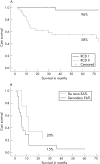Survival in refractory coeliac disease and enteropathy-associated T-cell lymphoma: retrospective evaluation of single-centre experience
- PMID: 17470479
- PMCID: PMC2000250
- DOI: 10.1136/gut.2006.114512
Survival in refractory coeliac disease and enteropathy-associated T-cell lymphoma: retrospective evaluation of single-centre experience
Abstract
Background: Coeliac disease may be regarded as refractory disease (RCD) when symptoms persist or recur despite strict adherence to a gluten-free diet. RCD may be subdivided into types I and II with a phenotypically normal and aberrant intraepithelial T-cell population, respectively. RCD I seems to respond well to azathioprine/prednisone therapy. RCD II is usually resistant to any known therapy and transition into enteropathy-associated T-cell lymphoma (EATL) is common.
Aim: To provide further insight into RCD and the development of EATL, by reporting on long-term survival and risk of transition of RCD into EATL in a large cohort of patients with complicated coeliac disease.
Design and methods: Retrospective comparison of responses to therapy in four groups of patients with complicated coeliac disease: 43, RCD I; 50, RCD II (total), of whom 26 with RCD II developed EATL after a period of refractoriness to a gluten-free diet (secondary EATL) and 13 were EATL patients without preceding history of complicated coeliac disease (de novo EATL).
Results: No coeliac-disease-related mortality was recognised in the RCD I group. The overall 5-year survival in the RCD I group it was 96%; in the RCD II (total) group was 58%; and in the RCD II group after developing EATL it was only 8%. The 2-year survival in the de novo EATL group was 20% versus 15% in secondary EATL group (p = 0.63). Twenty-eight (56%) of the 50 patients with RCD II died, 23 (46%) due to EATL, 4 due to a progressive refractory state with emaciation and 1 from neurocoeliac disease.
Conclusion: Remarkably, no patient with RCD I developed RCD II or EATL within the mean follow-up period of 5 years (range 2-15 years). A total of 52% of the RCD II patients developed EATL within 4-6 years after the diagnosis of RCD II. More aggressive and targeted therapies seem necessary in RCD II and EATL.
Conflict of interest statement
Competing Interests: None to declare.
References
MeSH terms
Substances
LinkOut - more resources
Full Text Sources
Medical

